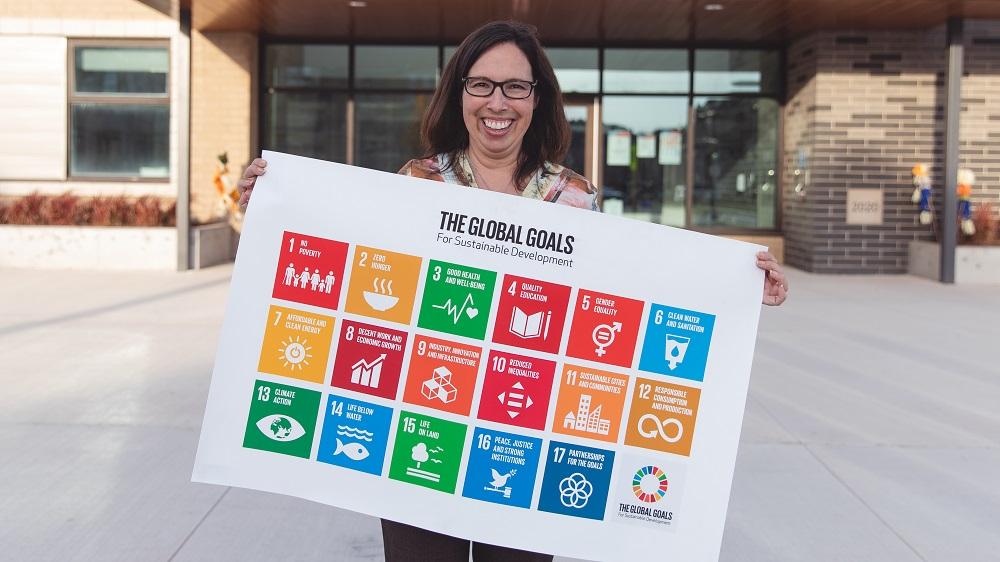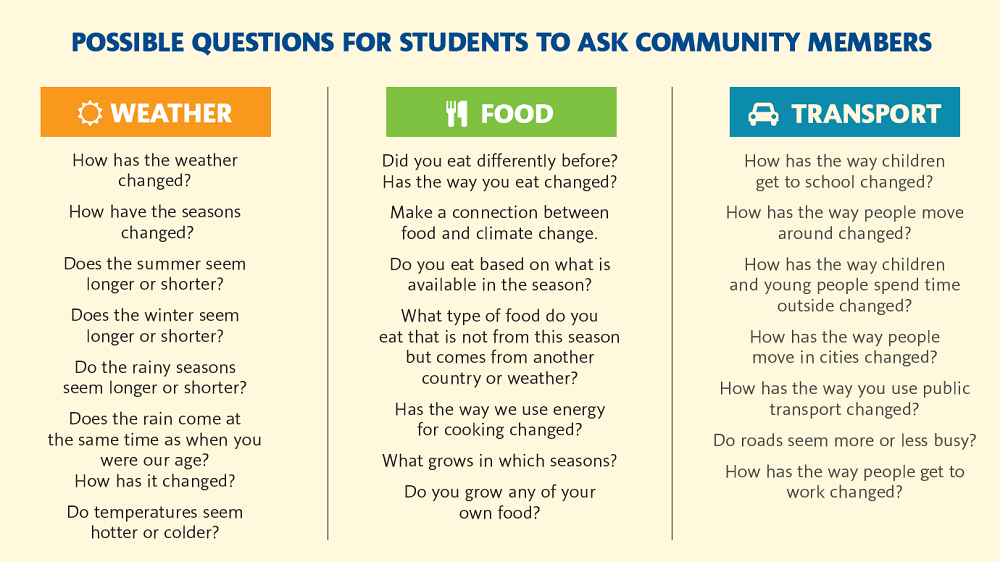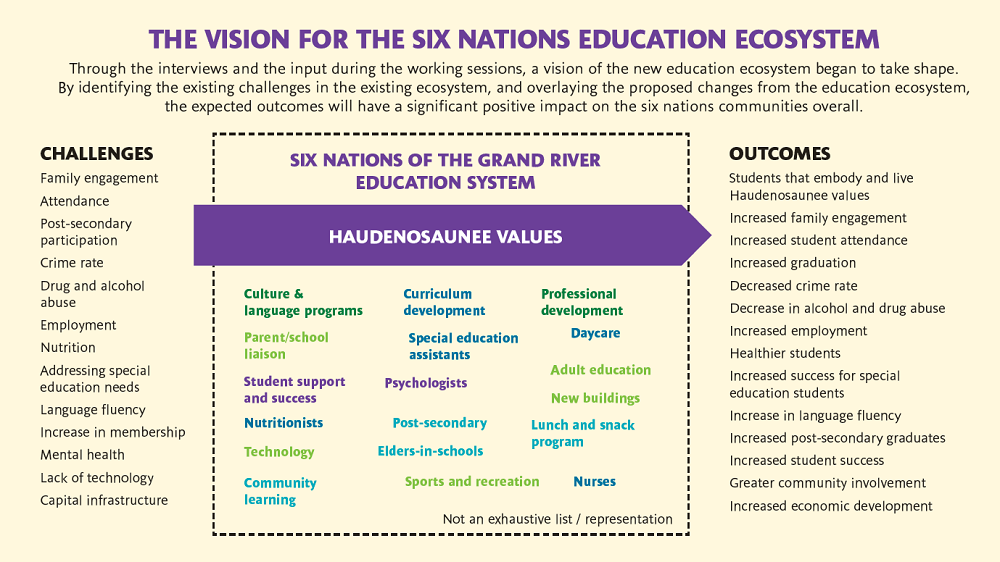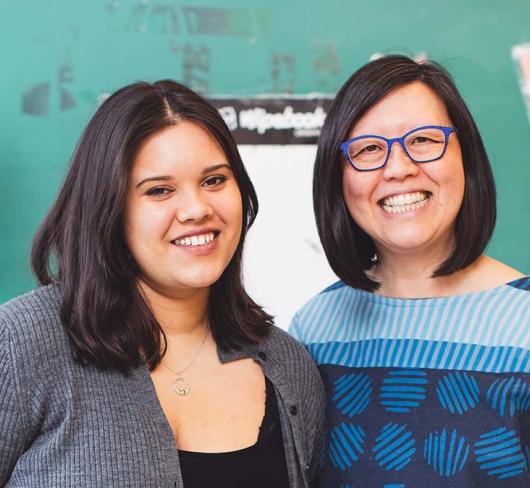
Building Towards 2030: Using the UN Global Goals to Foster Advocacy in Design
One of the biggest surprises of the shutdown that came with the surge of COVID-19 cases last spring was the environmental impact. Photos of grounded airplanes and empty highways, wild animals moving into cities and satellite images of reduced carbon emissions stopped us in our tracks with thoughts of what this moment could potentially do for the climate emergency. As teachers, we like to bring good news to students whenever we can. For a while, news such as reports of China reducing greenhouse gas emissions by 25 percent at the start of 2020 offered a glimmer of hope. People were learning how to bake and cook together again. Pictures of new crafts, making do with what we had instead of buying more and connecting over social media to ask and offer help brought a taste of a more sustainable culture. Parents forced to work from home found time to play again and more people made runs and walks outside part of their daily routines.
We now know the increase in deliveries and reduced recycling efforts during isolation have likely made up for the initial drop in emissions. We are waiting to see whether our increased reliance on items that aren’t shared will affect our overall consumption patterns.
In our conversations with students about science and social studies, however, we now have a few months of images that connect to a choice. We may choose, as a society, to return to the consumption habits of last year. This year, I challenge you to consider another option with your students.
“Historically, pandemics have forced humans to break with the past and imagine the world anew. This one is no different. It’s a portal: a gateway between one world and the next. You can choose to walk through it dragging the carcasses of our prejudice and hatred, our avarice, our database and dead ideas...or we can walk through it lightly, with little luggage, ready to imagine another world. And ready to fight for it.”
– Arundhati Roy, author and political activist, The Pandemic is a Portal, YouTube
What if we continued that impulse to use what we have before ordering more? What if we celebrated and fostered nature and naturalized spaces that grew during the summer? What if we took daily outdoor walks for mental health, made reaching out and offering help and noticing when people are in need a continued practice as the world comes out of the pandemic? Now that we have seen the power of choices, what if there was a way to foster that drive for social change using the power in our classrooms?
A Global Effort to Change
“The whole planet is at stake. So this is a moment to recognize that the way we have been moving leads nowhere and that we need to change course.”
– António Guterres, Secretary General of the United Nations (Sept. 19, 2020)
In 2015, the 193 member states of the United Nations agreed to 17 goals to be met within 15 years. They called these goals the UN Global Goals for Sustainable Development (UNGGSD). Leaders in the efforts to meet these goals get together every September to discuss how countries are doing with the targets in each of the 17 areas. By 2030, work in these areas is intended to reduce poverty, tackle climate change and improve the sustainability of ecozones worldwide.
Bringing UNGGSD into your class is easy and there is nothing like a global pandemic to get us thinking about how to build a more sustainable future. Within each goal there are many targets that provide the opportunity to link goals to the curriculum or the events you are discussing in class. For example, Goal 10, Reduced Inequality linked to our discussions around Orange Shirt Day and Goal 15: Life on Land connected nicely to a Grade 1 Life Systems discussion about what would happen if mosquitos disappeared. There is even a collection of comics written for the global goals which tie into Literacy. The goals are broad enough to provide entry points for homeroom and rotary teachers.
For example:
(un.org/sustainabledevelopment/news/communications-material/)
Goal 2: Zero Hunger
Ensure access to clean, nutritious food for everyone especially people who are vulnerable.
(link to Healthy Living and Geography)
Goal 3: Good Health and Well-Being
Prevent substance abuse and promote mental health and wellness.
(link to Healthy Living, Science, Math and Media)
Goal 10: Reduced Inequality
Make sure everyone, especially those who are inadequately supported, has equitable access to housing, food, education, work and medical care.
(link to Social Studies, Literacy, Science)
Goal 12: Responsible Consumption and Production
Reduce food waste and achieve sustainable management of natural resources.
(link to Ecology, Ecoschools, Healthy Living and Data Management)
The United Nations Global Goals for Sustainable Development have been one way I have approached creating an environment of hopeful innovation in my classroom. Through its site and the companion education site, The World’s Largest Lesson, I have been able to bring advocacy, a sense of empowerment and, more importantly, a sense of hope to conversations about equity and the environment.
“I think you can be a change maker right now. If you are 11, if you are 16, if you are, you know, 30, 40. Change is possible anytime and I want you to believe in yourself and make this world a fairer, a more equal and a better place for each and every one.”
– Malala Yousafzai, Urgent Solutions for Urgent Times, YouTube
Starting Off with a Design Challenge
To introduce the Global Goals, I use a video from the Global Goals YouTube channel (my students like “World’s Largest Lesson: Our Inspiration,” which shows children finding solutions narrated by Emma Watson). I also have a set of cards with the image for each Global Goal on one side and one or two targets on the back written in age-appropriate language.
Depending on the grade, give the student or group of students a choice of two, four or six of the cards so they can choose the Global Goals they are interested in. They will be challenged to build a solution to meet one of the goals using what we call “loose parts.” Loose parts can be anything (my loose part bags have sticks, stones, Plasticine, cut up cereal boxes, twist ties, paper, plastic figures, marbles and string) and we reuse the parts to build challenges throughout the year. This is a quick build; they only have 20 minutes and there is no incorrect answer.
After 20 minutes, ask volunteers to present their ideas and the Global Goal they want to target. Have some fun with the presentations and celebrate their success as the world-changing brave people they are. Here are some ideas I have used:
- Put up a flashy slide and power music and have them strut the innovation on an imagined red carpet.
- Invite a member of the administration via Google meet or in person to be the “Dragon” for a Dragons’ Den style presentation.
- Create amazing improvised commercials complete with a rhyming slogan.
Now that the students have selected the target or targets they are interested in, frame the conversation with real world examples, coding challenges and simulations using the ideas in The World’s Largest Lesson. This website will give you the tools to explore specific Global Goals in more detail including simulations, videos, comics, build challenges and coding activities. In Canada, kidscode-jeunesse and the Ontario Science Centre have guided tutorials for coding activities using the Global Goals and the Micro:bit. For example, my students tackled the goal of healthy living by coding and testing a step counter and a mindful breathing app.
Become a Story Collector
“Everything that we do now is going to make a difference in our future. So we need to ask ourselves, what are we going to be in the story that we are in right now? Are we going to be a villain or are we going to be a hero? But one thing is absolutely for sure. Whatever we do right now is going to be the next part of the story.”
– Bomgiizhik (Isaac Murdoch) (helpingourmotherearth.com/sacred-fisher-story.html)
Now that students have a general overview of the Global Goals, post the images and connect them to the stories in your class. In my experience, students are most passionate about the goals if the goals link to someone or something they actually know. You can collect stories from local newspapers, use interviews with family members or take photos and simply ask, “What do you notice? What do you wonder?”
A student in Grade 7 heard her mom telling stories about difficulties getting her twin stroller around local businesses and it prompted her to look at Goal 10: Reduced Inequality. She wrote letters to stores asking for wider passages between shelves and created a list of local businesses with working ramps, automatic doors and washrooms for people like her mother to use.
Marianne Meed Ward, mayor of Burlington, asked my students for their help cleaning nurdles (small plastic pellets) off the local beach. After watching the video request, the class created solutions to the problem of removing plastic from the shoreline and tested it using sand I had brought in from the beach in some jars. The students were excited to be helping the mayor and even went to the beach on a cold March weekend to survey the sand and test out designs without being asked.

From worldslargestlesson.globalgoals.org/resource/community-conversations-for-climate-change/
A survey of class garbage sorting after lunch resulted in two questions at the same time. One group looked at the amount of processed food in packed lunches and created visual representations of the amount of sugar in juice boxes as a way to encourage students to choose water and fresh fruit more often (Goal 2: Zero Hunger). The other group coded a game to teach younger students to properly sort and reduce waste and held a competition to see which class improved most (Goal 12: Responsible Consumption and Production).
“The passion for protests can turn into a passion for changing all of our behaviour to create a better, safer, just, sustainable world.”
– Don Cheadle, UNEP Goodwill Ambassador
It is vital to bring in the stories and voices of Indigenous advocates in the areas where we live and teach. My school is in Treaty 23 and I am fortunate I am able to bring in (virtually this year) Knowledge Holders and Elders from many Indigenous Nations including our Treaty partners, the Mississaugas of the Credit First Nation. Many of the Global Goals are also part of Indigenous Ways of Knowing. For example, students in my current Grade 4 class listened intently to Peter Schuler, an Elder from the Mississaugas of the Credit First Nation, talk about food access and harvesting when he was young. This sparked an interest in native plants in our community, which is easily linked to Science and Goal 15: Life on Land. I often hear that the videos we watch are being spontaneously shared at home and the stories are used by the students in their explanations later in the year.
This is also a way to connect to family members. Ask your students to gather their stories and they will be supportive of what you are trying to do. The World’s Largest Lesson has a plan you can download that gives students questions and explores the changes to the climate. My Grade 7 students’ parents remember deeper snow, more insects and milder summers. The stories that parents tell help reinforce a bond and make what students are learning more concrete.
Integrate
Just as it is difficult to find a solution that affects just one Global Goal, it is difficult to separate Literacy from Science, Math, Geography and often Healthy Living. Embrace this integration and dissolve the lines between the subjects in the schedule while working on building a solution to a Global Goal target. For example, the Six Nations of the Grand River (near Hamilton, Ontario) is working on creating a school system to better meet their needs. Work they are undertaking falls under the targets of Goal 4: Quality Education. Looking at the infographic they created, it is clear that it also involves other Global Goals such as improving nutrition and mental health as well as access to language, traditional harvesting and cultural practices. Showing that organizations are working on similar issues as they are helps empower the students and keep the learning current.

Our lessons in Global Goals show how subjects connect. We incorporate lessons in visual art (how do colour and line make the innovation appealing to users?), coding, media, geography and data management in most of our projects throughout the year. We collect stories of positive news (the People Fixing the World Podcast is great for them). We celebrate the changes we have brought to local stories. Highlights include a collection of towels for the Humane Society organized by a student or woven plastic mats made out of milk bags distributed by a class to countries affected by tsunamis through milkbagsunlimited.ca.
“We have hope. We have enormous potential of what children can achieve together...if we let them.”
– Sugata Mitra, Professor of Educational Technology, Newcastle University
This year presents an opportunity for a shift in practice, an invitation to show students the connections between subjects and to ask them to dream of solutions to real problems. Through the 2020 school shutdown and reboot, we were given a view of what we value and what needs to change. Now that school has begun in this new way, it is up to us, as teachers, to look at climate change, inequalities and connection to the land and water in a new way. This isn’t about rote learning; it’s role learning. It’s about embracing responsibilities and empowering change. Though it can be daunting to set out on this path, there is a worldwide network of educators who will support you. Together, as the UN Global Goals motto states, we will “Leave no one behind.”
Joanne Arcand is a member of the Halton Teacher Local.
Resources
World’s Largest Lesson:
- Our Inspiration
youtube.com/watch?v=lOCFpsWaSrs - My students’ favourite introduction with Emma Watson
youtube.com/watch?v=Qx0AVjtdq_Q - Act Now
un.org/en/actnow/ - The World’s Largest Lesson
worldslargestlesson.globalgoals.org/
Ages 4-8:
- Explorers for the Global Goals
worldslargestlesson.globalgoals.org/resource/explorers-for-the-global-goals-activity-pack-for-teachers/
Ages 8-12:
- The Pandemic is a Portal. Time to Reset
worldslargestlesson.globalgoals.org/resources
Any Age:
- Teach SDGs has a platform with resources and mentor teachers who will guide you teachsdgs.org/resources.html
- Ontario Science Centre STEM resources about the Global Goals
ontariosciencecentre.ca/teachers-plus-students/teacher-resources/stem-education-toolkit - The 2020 Climate action project
climate-action.info/ - Fact sheets for each of the global goals
un.org/sustainabledevelopment/poverty/ - The Global Goals Comics
margreetdeheer.com/eng/globalgoals.html and comicsunitingnations.org/ - Progress on the global goals
unstats.un.org/sdgs/report/2019/ - Project Helping Our Mother Earth
See the section on Life On Land.
helpingourmotherearth.com/ - People Fixing the World
A podcast by BBC looking at good news stories about the environment.
bbc.co.uk/programmes/p04grdbc/episodes/downloads
